|
Volvo S40 / V50
Debut: 2004
Maker: Volvo
Predecessor: S40 / V40 (1995)
|
|
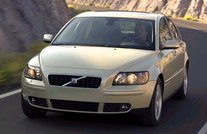 I
like Volvo’s car-making philosophy - safe, practical and comfortable.
Unlike
German executive cars, it doesn’t pretend to be sophisticated,
high-quality
or luxurious. It just delivers reliability and dependability. Volvos
are
cars that you can trust. Therefore I like Volvo S40. Although it was
derived
from the next Ford Focus platform (also shared with Mazda 3), I am
delighted
that it preserves all the aforementioned qualities and looks / feels so
different from its sisters. This is a true Volvo. I
like Volvo’s car-making philosophy - safe, practical and comfortable.
Unlike
German executive cars, it doesn’t pretend to be sophisticated,
high-quality
or luxurious. It just delivers reliability and dependability. Volvos
are
cars that you can trust. Therefore I like Volvo S40. Although it was
derived
from the next Ford Focus platform (also shared with Mazda 3), I am
delighted
that it preserves all the aforementioned qualities and looks / feels so
different from its sisters. This is a true Volvo.
The
last generation S40 shared its platform with Mitsubishi Carisma and was
built at a joint-venture plant at Holland. As the company is now under
the umbrella of Ford, production of the new car is shifted to Ford’s
factory
at Ghent in Belgium. Volvo expects to sell 70,000 S40s a year.
In
this report, I will avoid comparing the new S40 with the old one
because
we all know the latter was a bad car, never being competitive
throughout
its life. Saying the new S40 improved this or that from the old car is
rather meaningless. It is better to compare it with direct competitors
such as Audi A3 and BMW 1-series.
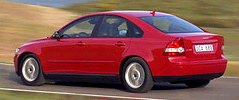 In
terms of styling, the S40 is a success. Styled under the leadership of
Peter Horbury (one of my favourite designers of current generation),
Volvo
managed to extend its big car feel to its smallest car. What you see is
a compact body sculpted with Volvo’s trademark grille, V-shape bonnet
and
pronounced shoulder lines running from the nose to the taillights. It
looks
nothing like a disguised Ford. In
terms of styling, the S40 is a success. Styled under the leadership of
Peter Horbury (one of my favourite designers of current generation),
Volvo
managed to extend its big car feel to its smallest car. What you see is
a compact body sculpted with Volvo’s trademark grille, V-shape bonnet
and
pronounced shoulder lines running from the nose to the taillights. It
looks
nothing like a disguised Ford.
The
body measures 4468mm in length and 1770mm in width, close to the league
of Audi A4 and BMW 3-series, but its rivals are actually a class lower,
whereas its 2640mm wheelbase shines. Compare with Audi A3, the baby
Volvo
offers noticeably more space, especially rear seat legroom. Headroom at
the rear is not as remarkable, but enough for 6-footers. Being a sedan,
its 404 litres boot is also a lot bigger than rivals. For the same
money,
you get more comfort and practicality in a Volvo than other prestige
brands.
The
interior design is clean and simple. As in other Volvos, the leather
seats
are comfy while ergonomics is generally good. Center console is an
innovation:
all the controls and its circuits are housed inside the thin console
panel,
leaving a useable storage bin behind it. This "floating console" looks
like coming from B&O design and is especially stylish in aluminum
trim.
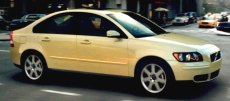 Despite
of platform sharing, Volvo designed its own chassis using its safety
know-how.
4 different grades of steel are employed to construct multiple crumple
zones such that the crash process is better controlled. The pronounced
bonnet leaves 70mm space between it and the engine, ensuring the
compliance
of pedestrian safety law. The 5-cylinder engine is also modified to be
slimmer and narrower, leaving a lot of space between the front crash
structure
and the engine. Safety is always a strong card of Volvo. Despite
of platform sharing, Volvo designed its own chassis using its safety
know-how.
4 different grades of steel are employed to construct multiple crumple
zones such that the crash process is better controlled. The pronounced
bonnet leaves 70mm space between it and the engine, ensuring the
compliance
of pedestrian safety law. The 5-cylinder engine is also modified to be
slimmer and narrower, leaving a lot of space between the front crash
structure
and the engine. Safety is always a strong card of Volvo.
5 petrol
engines and 2 diesel engines are offered: 100hp 1.6 16V (from Ford),
125hp
1.8 16V (also Ford), 140hp 2.4 five-cylinder 10V, 170hp 2.4
five-cylinder
20V, 220hp 2.5 five-cylinder 20V VVT turbo (using in T5), 110hp 1.6
turbo
diesel (Ford-PSA) and 136hp 2.0 turbo diesel (Ford-PSA). If you want to
see the true colors of Volvo, the 5-cylinder engines are definitely
recommended
- they were originally designed by Porsche and since then became the
trademark
of Volvo. Being smoother than ordinary 4 cylinder engines and producing
musical sound, they are the best Volvo can slot into its transverse
engine
compartment.
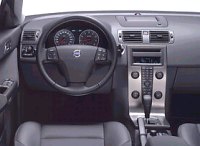 The
T5 engine is the best of the bunch. Its low pressure turbocharger
produces
220 horsepower and a linear torque curve which peak at 236 lbft. With
almost
no lag, power delivery is smooth. The 6-speed manual transmission has
tall
gear ratios to favour relaxed cruising and fuel consumption rather than
acceleration - this makes sense to the character of Volvo. Despite
that,
S40 T5 can still accelerate to 60mph in less than 7 seconds, about the
same as the top A4 and 3-series. The
T5 engine is the best of the bunch. Its low pressure turbocharger
produces
220 horsepower and a linear torque curve which peak at 236 lbft. With
almost
no lag, power delivery is smooth. The 6-speed manual transmission has
tall
gear ratios to favour relaxed cruising and fuel consumption rather than
acceleration - this makes sense to the character of Volvo. Despite
that,
S40 T5 can still accelerate to 60mph in less than 7 seconds, about the
same as the top A4 and 3-series.
The
C1 platform donates some vital and costly components to S40: the front
MacPherson strut suspensions, the control-blade multi-link rear
suspensions
(which gives Ford Focus unrivalled handling and ride) and
electro-hydraulic
power steering. In the Volvo, the tuning biases towards comfort and
security
rather than driver appeal, but you can still see its good genes from
the
fluency of handling, plenty of grip, fine stability and fine steering
feedback.
It lacks the sharpness, superb body control and neutrality of BMW
1-series,
but its capability matches that of the A3 and exceeds it in terms of
fun.
Supple ride ensures a relax driving character.
Car
makers rarely produce bad cars these days, but what a pity their cars
look
and feel closer and closer to each other. We are glad that in this
platform
/ component-sharing age Volvo remains unique in character. The S40
looks
and feels like no other cars in the segment, nor relegated to the Ford
Focus category. It preserves the fine qualities of Volvo - safe,
comfort
and practical. It deserves a success. |
| The
above report was last updated on 10 Jul
2004. All Rights Reserved. |
V50
|
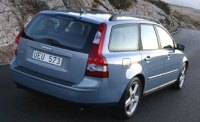 While
V70 is a stand-alone car, V50 is simply an estate version of S40. Its
rivals
is likely to be Audi A4 Avant and BMW 3-series Touring, but the Volvo
will
undercut their prices by about 10%. While
V70 is a stand-alone car, V50 is simply an estate version of S40. Its
rivals
is likely to be Audi A4 Avant and BMW 3-series Touring, but the Volvo
will
undercut their prices by about 10%.
Disappointingly,
the baby Volvo based on Ford’s common platform is not optimized for
luggage
space. At 414 litres, it cannot match A4 Avant. Luckily, drop down the
rear seats and this increases to 1307 litres, exceeding its rivals.
Moreover,
the front passenger seatback can fold down to place long things such as
surf boards.
The
estate car offers the same range of engines as S40, but to most the
torquey
(236lbft / 136hp) 2.0 turbo diesel is most suitable to its usage. Like
S40, AWD is optional. |
| The
above report was last updated on 10 Jul
2004. All Rights Reserved. |
|
|